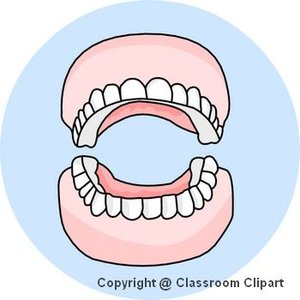Dental cavities
|
|
| Contents |
Causes
Dental caries (tooth decay) is one of the most common of all disorders, second only to the common cold. It usually occurs in children and young adults but can affect any person. It is the most important cause of tooth loss in younger people.
Bacteria (such as peptostreptococci) are normally present in the mouth. The bacteria convert foods—especially sugar and starch—into acids. Bacteria, acid, food debris, and saliva combine in the mouth to form a sticky substance called plaque that adheres to the teeth. It is most prominent on the grooved chewing surfaces of back molars, just above the gum line on all teeth, and at the edges of fillings. Plaque that is not removed from the teeth mineralizes into calculus (tartar). Plaque and calculus irritate the gums, resulting in gingivitis and ultimately periodontitis.
The acids in plaque dissolve the enamel surface of the tooth and create holes in the tooth (cavities). Cavities are usually painless until they grow very large inside the internal structures of the tooth (the dentin and the pulp at the core) and can cause death of the nerve and blood vessels in the tooth. If left untreated a tooth abscess can develop.
Plaque and bacteria begin to accumulate within 20 minutes after eating, the time when most bacterial activity occurs. If plaque and bacteria are left on the teeth, cavities can develop, and untreated tooth decay can result in death of the internal structures of the tooth and ultimately the loss of the tooth.
Dietary sugars and starches (carbohydrates) increase the risk of tooth decay. The type of carbohydrate and the timing and frequency of ingestion are more important than the amount. Sticky foods are more harmful than nonsticky foods because they remain on the surface of the teeth. Frequent snacking increases the time that acids are in contact with the surface of the tooth.
Symptoms
- toothache -- particularly after sweet or hot or cold foods or drinks
- visible pits or holes in the teeth
Signs
An examination of the teeth reveals dental caries (cavities). Most dental caries are discovered in the early stages during routine checkups. The surface of the tooth may be soft when probed with a sharp instrument, such as a dental explorer. Pain may not be present until the advanced stages of tooth decay. Dental X-rays may show some cavities before they are visible to the eye.
Treatment
Destroyed tooth structure does not regenerate. However, the progression of dental caries can be stopped by treatment. The goal of treatment is to preserve the tooth and prevent complications.
In filling teeth, the decayed material is removed (by drilling) and replaced with dental fillings, made of a restorative material such as silver alloy, gold, porcelain, or composite resin. Porcelain and composite resin more closely match the natural tooth appearance, and may be preferred for front teeth. Many dentists consider silver amalgam (alloy) and gold as stronger, and these materials are often used on back teeth, although there is a trend to use high strength composite resin in the back teeth as well.
Crowns are used if decay is extensive and there is limited tooth structure which may cause weakened teeth. Large fillings and weak teeth increase the risk of the tooth breaking. The decayed or weakened area is removed and repaired and a covering jacket or "cap" (crown) is fitted over the remainder of the tooth. Crowns are often made of gold, porcelain or porcelain fused to metal.
A root canal is recommended if the nerve (pulp) in a tooth dies from decay or from a traumatic blow. The center of the tooth, including the nerve and vascular (blood vessel) tissue (pulp), is removed along with decayed portions of the tooth. The roots are filled with a sealing material. The tooth is filled and a crown may be placed over the tooth if needed.
Removal of the decayed tooth extraction is performed if the tooth is too far destroyed from the decay process to effectively restore, or if the tooth considered non-functional (lack of opposing tooth, or tooth is in a non-useful position) or the patient does not wish to undergo the expense or procedure of restoring the tooth.
Expectations
Treatment often preserves the tooth. Early treatment is less painful and less expensive than treatment of extensive decay. Anesthetics -- local, nitrous oxide (laughing gas), or other prescription medications -- may be required in some cases to relieve pain during or following drilling or other treatment of decayed teeth. For those who fear dental treatment, nitrous oxide anesthesia may be preferred.
Prevention
Oral hygiene is the primary prevention against dental caries. This consists of personal care (proper brushing at least twice a day and flossing at least daily) and professional care (regular dental examination and cleaning, every 6 months). Select X-rays may be taken yearly to detect possible cavity development in high risk areas of the mouth.
Chewy, sticky foods (such as dried fruit or candy) are best if eaten as part of a meal rather than as a snack. If possible, brush the teeth or rinse the mouth with water after eating these foods. Minimize snacking, which creates a constant supply of acid in the mouth. Avoid constant sipping of sugary drinks or frequent sucking on candy and mints.
The use of dental sealants is a good means of cavity prevention. Sealants are thin plastic-like coating applied to the chewing surfaces of the molars. This coating prevents the accumulation of plaque in the deep grooves on these vulnerable surfaces. Sealants are usually applied on the teeth of children, shortly after the molars erupt. Older people may also benefit from the use of tooth sealants.
Fluoride is often recommended to protect against dental caries. It has been demonstrated that people who ingest fluoride in their drinking water or by fluoride supplements have fewer dental caries. Fluoride ingested when the teeth are developing is incorporated into the structure of the enamel and protects it against the action of acids.
Topical fluoride is also recommended to protect the surface of the teeth. This may include a fluoride toothpaste or mouthwash. Many dentists include application of topical (applied to a localized area of the skin) fluoride solutions as part of routine visits.
It has also been found that certain kinds of cheese like cheddar can help counter tooth decay if eaten soon after having eaten foods potentially harmful for teeth.
Anatomy Clipart and Pictures
- Clip Art (https://classroomclipart.com)
- Anatomy Illustrations (https://classroomclipart.com/clipart/Illustrations/Anatomy.htm)
- Anatomy Clipart (https://classroomclipart.com/clipart/Anatomy.htm)
- Anatomy Animations (http://classroomclipart.com/cgi-bin/kids/imageFolio.cgi?direct=Animations/Anatomy)
External links
- NIH site on Dental caries (http://www.nlm.nih.gov/medlineplus/ency/article/001055.htm)


